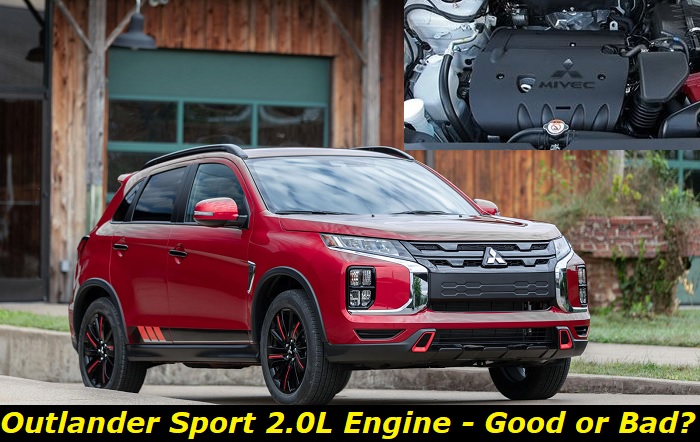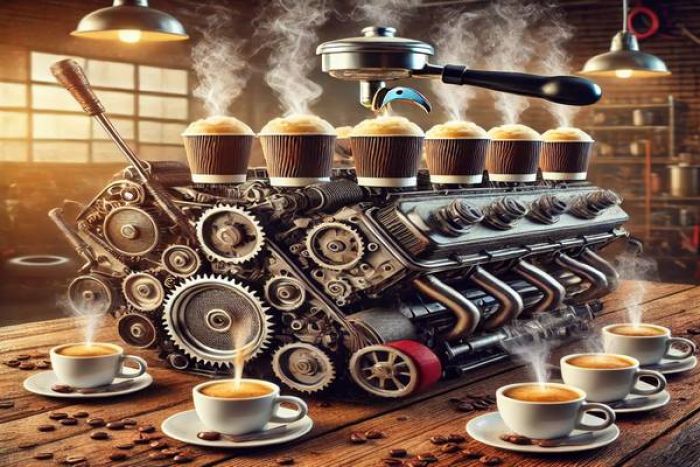If you're looking for a compact SUV, the 2022 Mitsubishi Outlander is a must-see. The Outlander has a premium appearance and a slew of standard equipment. Most importantly, it has up to seven-seating capacity despite costing almost the same as its five-seater rivals in the market.
When it comes to its engine, particularly the 2.0L that we will be reviewing here, rest assured that you are in for a powerplant that you can truly rely on for your daily drives as well as work and recreational activities.

Key features and my opinion about the engine
- Production years:2006-now
- Average lifespan of 4B11:220,000-240,000 miles
- Fuel supply type:port injection
- Power range:145-155 hp
- Fuel efficiency:good
- Engine block material:aluminum
- Engine reliability score:high
- The most common problems:oil consumption, timing chain stretching, weak phasers, oil leaks, noisy work with vibrations.
Mitsubishi Outlander Sport 2.0L Engine: Longevity
The Mitsubishi Outlander Sport 2.0L 4B11 engine is a tough one. It is estimated to last between 200,000 and 250,000 miles if basic maintenance and service intervals are followed. Based on an average drive of 15,000 miles annually, it can provide 13 to 17 years of service before requiring costly repairs.
Do note, however, that there have been many complaints about its transmission and electrical components that could potentially affect the operation of your engine in some way.
Most Common Problems Encountered by Mitsubishi Outlander Sport 2.0L Engine Users
As mentioned, the Mitsubishi Outlander 2.0L engine is very resilient. The same cannot be said about the other parts of the SUV though because it is particularly known for its brake, clutch, transmission, and electrical issues. Although we will tackle some of them in this section, our primary focus lies on the problems directly linked to the engine.
1. Cooling Fan Controller Failure
The cooling fan controller is a very important part of an engine's cooling system. It controls the operation of the cooling fans, which are responsible for keeping the temperature of the engine within the recommended levels. When the controller fails, the fans will not operate correctly and the engine can overheat.
Several symptoms can indicate a problem with the cooling fan controller. The most obvious is when the temperature gauge on the dashboard shows that the engine is running hot. Another symptom is if the engine starts to run rough or stalls. This can be caused by the fans not being able to cool the engine properly, causing it to overheat.
The most common cause of cooling fan controller failure is a blown fuse. This can be caused by a number of things, such as a short circuit or an electrical surge. If the fuse is blown, it will need to be replaced. Another possible cause is a faulty relay. This can be caused by a number of things, such as dirt or corrosion. If the relay is faulty, it will need to be replaced.
There are a few possible solutions to this problem. The first is to replace the fuse. This is usually the easiest and most economical solution. The second is to replace the relay. This is usually more expensive than replacing the fuse, but it will fix the problem if the relay is indeed faulty. The third solution is to replace the entire cooling fan controller assembly. This is usually the most expensive option, but it will ensure that the problem is fixed and that the engine will be able to cool properly.
No matter which solution you choose, it is important to have the problem diagnosed and repaired as soon as possible. If the engine overheats, it can cause serious damage. Therefore, it is important to take immediate action as soon as you notice any of the symptoms listed above. Waiting too long can result in expensive repairs or even a complete engine replacement.
2. Crankshaft Position Sensor Malfunction
The crankshaft position sensor is a very important part of the engine. It ensures that the engine is running smoothly and efficiently. If there is a problem with the crankshaft position sensor, it can cause the engine to run erratically or even stall.
When diagnosing a crankshaft position sensor fault code in the Mitsubishi Outlander Sport 2.0L engine, it is important to first check for any other codes that may be present. If there are no other codes, then the crankshaft position sensor may be the only issue.
There are several possible causes of a crankshaft position sensor fault code. One possibility is that the sensor itself is faulty. Another possibility is that there is an issue with the wiring or connectors. Given the electrical issues that the SUV is prone to, the problem most likely lies in the circuitry of the sensor, though other parts should not be dismissed. With that, it is also possible that there is a problem with the engine itself, specifically in the operation of the crankshaft.
Before anything else, make sure that the wirings and connectors of the sensor are in place and in good quality. You can easily spot bad wiring or connector just by looking for signs of burns or any type of physical damage.
You can also check their quality through a multimeter by checking for their continuity or resistance. If the wiring harness or the sensor shows no continuity or a high level of resistance, that means the part is no longer functioning well and needs to be replaced.
It is also important to mention that parts replacements may be necessary depending on the cause of the problem. For example, if the problem is caused by the crankshaft, it should be recalibrated or replaced depending on which is the most appropriate course of action as determined by your mechanic in the given situation.
3. Oxygen Sensor Banks 1 and 2 Error Codes
The oxygen sensor is an important part of the engine management system. It monitors the oxygen content of the exhaust gas and sends a signal to the engine control unit (ECU). The ECU then adjusts the air/fuel mixture accordingly.
A malfunctioning oxygen sensor can cause the engine to run lean or rich. This can lead to poor fuel economy, increased emissions, and engine damage.
There are two oxygen sensors in the Mitsubishi Outlander Sport 2.0L engine, one for each bank of cylinders (1 and 2). If either sensor fails, it will trigger an error code.
The most common cause of oxygen sensor deterioration is simply age. The other causes can include contamination (from oil, coolant, or fuel), a problem with the exhaust system (such as a leak), or strong vibrations.
If you get an error code for either of the oxygen sensors, the first thing you should do is check for any leaks in the exhaust system. If there are no leaks, then ensure that the engine's combustion is timed properly. If there are no leaks or calibration issues present, the most likely cause is a bad oxygen sensor, which you have to replace.
4. Engine Stalling During Reverse
A clogged transmission cooler line can cause the engine to bog. This is because the transmission cooler line helps to keep the transmission fluid cool, and if it becomes clogged, the fluid will not be able to circulate properly. This can cause the transmission to overheat, which can lead to the engine stalling. In the case of the Outlander, this is normally the element that's forcing its power unit to stall when put in reverse gear.
There are several possible causes of a clogged transmission cooler line. The most common cause is debris buildup in the line. This can happen over time as the transmission fluid breaks down and starts to accumulate dirt and other contaminants. Another possible cause is a leak in the transmission cooler line. If there is a leak, the fluid will escape and will not be able to circulate properly.
There are several possible solutions to a clogged transmission cooler line. One is to clean the line with a solvent or degreaser. This will help eliminate any debris that may be triggering the issue. Another remedy is to replace the transmission cooler line. This is usually only necessary if the line is damaged or leaking. If the transmission cooler line is clogged, it is also important to check the transmission fluid level and add more fluid if necessary.
A clogged transmission cooler line can be a serious problem that can cause the engine to bog down. It is important to take care of the problem as soon as possible to avoid further damage to the transmission and the engine.
Mitsubishi Outlander Sport 2.0L Engine Key Specs
The gasoline-fed 2.0L inline 4B11 engine of the Mitsubishi Outlander Sport features an inline-four layout with four valves per cylinder, variable valve timing (VVT), and double overhead camshaft (DOHC).
For an SUV of this size, a lot of people find the base 148 horsepower output of the 2.0-liter four-cylinder engine somewhat lacking in power. This is especially noticeable when accelerating from a stop or climbing on a steep slope.
Most people find more satisfaction in the improved 168 hp 2.4-liter inline-four featured in the GT and GT Special Edition models of the Outlander though. It may still be a bit underpowered compared to other alternatives in its segment of the market but it does deliver enough power to satisfy the loyal fans of Mitsubishi SUVs.
Both engines are partnered with a continuously variable automatic transmission (CVT), which a lot of critics think has plenty of room for improvement.
Conclusion
There are relatively few complaints related to the Mitsubishi Outlander Sport 2.0L engine, so we certainly recommend it on this basis. However, more careful thought should be given if we factor in the other problems of the SUV like the braking, transmission, clutch, and electrical issues.
It is also worth noting that some of the electrical issues that it is prone to can directly influence the operation of the engine, particularly its cooling system, as we have shown here. So, if you want to get the most out of your auto, these are the things that you should definitely watch out for.
About the authors
The CarAraC research team is composed of seasoned auto mechanics and automotive industry professionals, including individuals with advanced degrees and certifications in their field. Our team members boast prestigious credentials, reflecting their extensive knowledge and skills. These qualifications include: IMI: Institute of the Motor Industry, ASE-Certified Master Automobile Technicians; Coventry University, Graduate of MA in Automotive Journalism; Politecnico di Torino, Italy, MS Automotive Engineering; Ss. Cyril and Methodius University in Skopje, Mechanical University in Skopje; TOC Automotive College; DHA Suffa University, Department of Mechanical Engineering






Add comment